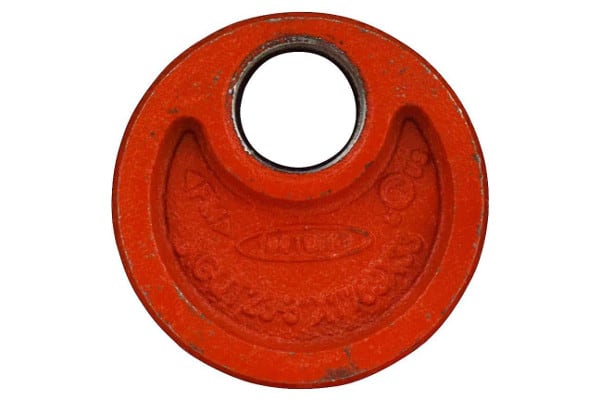Grooved drain caps make it easier to remove water from fire protection systems
There are many reasons you might need to drain a fire sprinkler system. But using the main drain isn’t always sufficient to remove every drop of water—leaving liquid trapped at low points or changes of direction in the piping. Grooved drain caps facilitate auxiliary drainage, making it simple to exhaust leftover water from these areas thoroughly.
They can also be used for air venting a system or extending system piping (of a smaller size) to another location—either to feed a sprinkler or to accomplish vents or drains that need to be accessible in a specific location.
In this blog, we explain the benefits of grooved drain caps and what you need to consider when purchasing them for a fire sprinkler system.
In the market for sprinkler system drain caps? Be sure to browse our selection of grooved drain caps and other fittings.
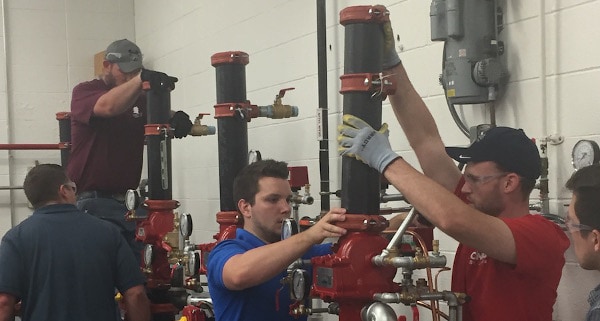
Why do you need to drain a fire sprinkler system?
NFPA 13: Standard for the Installation of Sprinkler Systems mandates that every sprinkler system design must include a way for it to be drained when needed.
From the 2019 edition of NFPA 13
16.10.1 General. All sprinkler pipe and fittings shall be installed so that the system can be drained.
Several events can prompt the need to drain a fire sprinkler system, including:
- Many circumstances can lead to sprinkler system repairs, such as improper maintenance, corroded pipes, damage caused by a natural disaster, or vandalized components. Fire sprinkler systems generally need to be drained before repairs can commence.
- Restoring an activated dry sprinkler system. Unlike wet systems, dry systems do not maintain water in their pipes. Instead, compressed air or nitrogen fills the pipes until the system is activated. If the system is tested or triggered, the water needs to be thoroughly drained to restore it to normal operation. And any pool of water left behind may mix with oxygen from pressurized air and corrode the pipes.
- Retrofitting/expanding an existing system. When the contents that a sprinkler system protects change over time, or a building gets an addition, it is often necessary to modify the existing sprinkler system to address the change in hazard or extend it to cover the new area. Water must be drained before work begins.
- Keeping up with codes and standards. New and existing rules that concern the age of sprinkler pipe, types of pipes, types of valves, and more could warrant system drainage so property owners can make the necessary changes to bring the system up to code.
To avoid damage to the sprinkler system or property, fire sprinkler systems should only be drained by qualified individuals approved by the local authority having jurisdiction (AHJ). It’s also important to consult the local AHJ before modifying a fire sprinkler system in any way. If systems are fully drained, impairment procedures detailed in Chapter 15 of the 2020 edition of NFPA 25: Standard for the Inspection, Testing, and Maintenance of Water-Based Fire Protection Systems must be implemented until they are restored to working order.
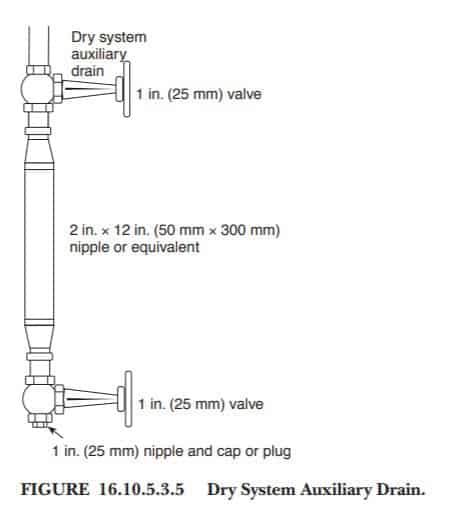
How do you drain a fire sprinkler system?
Generally, piping is connected to the main drain located at the system riser that’s designed to exhaust the system of water. Gravity propels the water to the drain—so, for this arrangement to work, piping needs to be installed to avoid trapped sections, such as those caused by up-and-down changes in pipe elevation.
Auxiliary drains pick up the slack when a change in direction or elevation prevents sprinkler pipes from evacuating through the main drain. Auxiliary drains are located at points where pipes change elevation or direction, generally utilizing a “T” connection instead of an elbow. These drains must be marked and easily accessible, especially in areas subject to freezing. One part of the change in direction flows to the remainder of the system; the other direction flows to the auxiliary drain.
The size and arrangement of auxiliary drains are based on whether they are attached to wet or dry systems and the capacity of the trapped section or sections of pipe. The larger the capacity of the trapped piping, the more elaborate the auxiliary drain connection. NFPA 13 requirements range from the simple removal of a pendent sprinkler to drain a trapped section of pipe to providing a drain connection that’s permanently piped and routed to the exterior of the building.
Drain caps or plugs may be at the end of auxiliary drains on dry systems, or on wet or preaction systems in areas not prone to freezing. The rules vary based on the “capacity of isolated trapped sections of pipe:”
From the 2019 edition of NFPA 13 (covering wet and preaction systems in areas not subject to freezing)
16.10.5.2.1 Where the capacity of isolated trapped sections of pipe is 50 gal (200 L) or more, the auxiliary drain shall consist of a valve not smaller than 1 in. (25 mm), piped to an accessible location.
16.10.5.2.2 Where the capacity of isolated trapped sections of pipe is more than 5 gal (20 L) and less than 50 gal (200 L), the auxiliary drain shall consist of a valve ¾ in. (20 mm) or larger and a plug or a nipple and cap.
16.10.5.2.3 Where the capacity of trapped sections of pipes in wet systems is less than 5 gal (20L), one of the following arrangements shall be provided:
(1) An auxiliary drain shall consist of a nipple and cap or plug not less than ½ in. (15mm) in size.
(2) An auxiliary drain shall not be required for trapped sections less than 5 gal (20 L) where the system piping can be drained by removing a single pendent sprinkler.
(3) Where flexible couplings or other easily separated connections are used, the nipple and cap or plug shall be permitted to be omitted.
From the 2019 edition of NFPA 13 (covering dry and preaction systems)
16.10.5.3.2 Auxiliary drains located in areas maintained at freezing temperatures shall be accessible and shall consist of a valve not smaller than 1 in. (25 mm) and a plug or a nipple and cap.
16.10.5.3.3 Where the capacity of trapped sections of pipe is less than 5 gal (20 L), the auxiliary drain shall consist of a valve not smaller than ½ in. (15 mm) and a plug or a nipple and cap.
Sprinkler systems also have test drains that are used to test the system pressure.
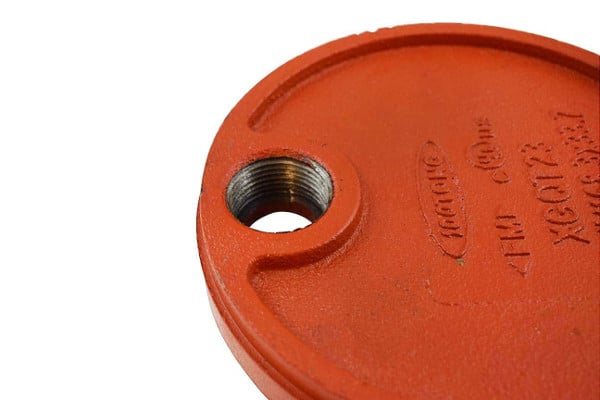
Tips for choosing the best grooved drain caps to drain or reduce grooved piping
Grooved drain caps close off grooved pipes used in fire protection, HVAC, plumbing systems, and more. This rigid pipe fitting seals the open end of the pipe run—and offers a convenient place for facility managers or maintenance professionals to access a small, end-of-the-line outlet.
Grooved pipe has become a popular method of pipe joining, tracing its roots back to both World Wars as a way of delivering water and petroleum via a faster, more reliable method of pipe connection. Smaller pipe thicknesses are permitted for grooved pipe, resulting in thinner pipe that is easier to transport, carry, and lift into place. With thinner, lighter pipe and easy grooved coupling options, grooved pipe can make labor less difficult and installations significantly faster.
Top-rated grooved caps—like the grooved drain caps carried by QRFS—are UL-listed and FM-approved fittings made of ferritic ductile cast iron. They are designed to meet ASTM and ANSI/AWWA requirements for use with grooved mechanical couplings. They are also finished with high-performance epoxy resin paint for better adhesion and resistance to corrosion.
These drain caps feature an NPT threaded outlet hole, or tap, to accommodate the installation of a small nipple and ball valve or a small plug, allowing water to drain without removing the entire cap. NPT (National Pipe Thread Tapered) is a U.S. national standard for measuring tapered threads used to join pipes and fittings as defined by ANSI/ASME B1.20.1 Pipe Threads, General Purpose, Inch. NPT threads pull tight, creating a leak-free seal.
The orientation of the pipe that needs to be drained determines what kind of drain cap is necessary:
- When pipes are installed horizontally, eccentric drain caps with an off-center outlet must be used. That way, the “tap” that water flows from can be located at the bottom of the cap to ensure no liquid remains trapped.
- For vertical applications, concentric drain caps that feature openings in the middle of the cap could be used as well, since water will drain no matter where the hole is located.
Eccentric drain caps can also be used to meet NFPA 13 requirements for venting air from wet sprinkler systems when filling them with water. In a vertical application, an eccentric drain cap and valve installed at the top or upper portion of a pipe or fitting can fulfill the requirement to exhaust air.
From the 2019 edition of NFPA 13
8.1.5 Air Venting. A single air vent with a connection conforming to Section 16.7 shall be provided on each wet pipe system utilizing metallic pipe (See A.16.7.)
The threaded outlet on a drain cap also infuses them with an intrinsic ability to accomplish a pipe-size reduction, as well as a connection-type transition fitting. Instead of needing a reducing coupling and adapter fitting, drain caps can be used as the reducer—extending the system line to a single sprinkler head or other smaller pipe size, as long as the connecting pipe has a male thread.
The only requirement: matching the size of the drain cap and NPT outlet to the pipes you aim to connect. For instance, the 8” Grooved Drain Cap with 1” NPT Outlet is an end cap designed to reduce 8” (203.2 mm) grooved pipe to a 1” (25.4 mm) threaded pipe. The 2 1/2″ Grooved Drain Cap with 1″ NPT Outlet is an end cap designed to reduce 2 1/2″ (63.5 mm) grooved pipe to a 1″ (25.4 mm) threaded pipe.
Standard drain caps feature a 1″ female threaded outlet, but other sizes are available. A smaller 1/4″ size, for example, can serve as a convenient system pressure gauge point.
While installing drain caps is simple, it’s essential to ensure that each cap that’s used is rated for the pressures faced by the system. Each cap must also be seated correctly with identifying marks facing outward and fully secure coupling bolts.
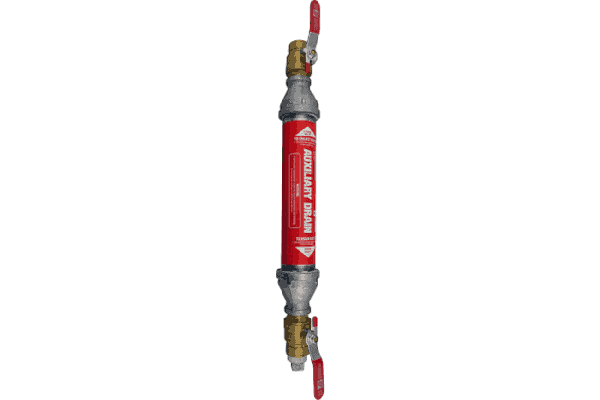
Using sprinkler drain caps to evacuate water from wet and dry fire protection systems
Using drain caps to remove water from a sprinkler system is pretty simple.
In a wet system, drain caps do what any outlet—think threaded fitting, mechanical “T,” or welded outlet—can do: providing a spot to install a plug or valve or serving as a pipe reducer. When the system needs to be drained, opening the valves on the main drain and all auxiliary drains will remove most if not all of the water. This resource provides a good step-by-step overview of draining a wet sprinkler system.
Drain caps offer a distinct advantage by doubling as an auxiliary drain for a wet system. Since the ends of grooved pipe or fittings need to be capped anyway, drain caps are a cost-effective way of killing two birds with one stone: sealing the pipe and creating a place to screw in a nipple and valve or to route piping to another valve at a further distance.
However, keep this in mind: The trick to using drain caps effectively comes down to ensuring that they are installed in locations that make them accessible for exhausting water. Remember, NFPA 13 only requires water to be piped to an accessible location when the capacity of the trapped sections of pipe is 50 gal (200 L) or more. Even then, the annex (A.16.10.5.2.1) merely suggests piping it to a valve located about 7’ (2.1 m) above the ground—which may or may not provide a good service point on a system.
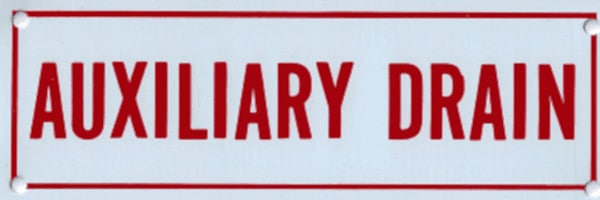
In a dry sprinkler system, auxiliary drains are more complex. Installing a drain cap directly onto a system pipe that only needs to be opened to drain water could cause the system to trip. If the cap’s valve or plug is accidentally opened, it will likely release the pressurized air or nitrogen that fills the pipes too fast for air maintenance equipment to keep up.
Instead, drain caps on dry sprinkler systems can be attached along with drum drips. These auxiliary drains are specifically designed to avoid accidentally activating dry systems while diverting and collecting extra water from trapped sections of pipes that hold more than five gallons.
Also known as a condensate trap or condensate drain, this device installs vertically, allowing water to fall from the pipes above and accumulate inside the large drum, or nipple, below. Two valves are alternately opened and closed, incrementally cycling trapped water through the drain without tripping the system.
Although some air is bound to escape along with the water, the incremental, manual fills of the drum allow the air compressor or nitrogen generator to keep up easily.
Read this to learn more about drum drips and how they are used to drain a system.
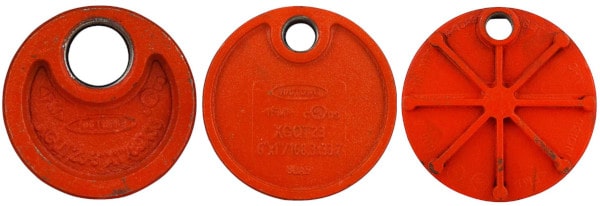
Grooved drain caps pick up the slack when main drains can’t sufficiently flush sprinkler systems—and help transition pipe in direction or size
When main drains can’t adequately remove all the water from a fire sprinkler system, grooved drain caps can facilitate easy flushing of excess water through auxiliary drains. And they serve as a convenient transitional fitting, allowing you to run smaller lines of threaded pipe for a variety of purposes. Following our tips will help you select the best grooved drain caps for your fire protection system.
In the market for sprinkler system drain caps? Be sure to browse our selection of grooved drain caps and other grooved fittings.
We also carry preassembled drum drips for use in dry or preaction systems:
Questions? Call us at +1 (888) 361-6662 or email support@qrfs.com.
This blog was originally posted at blog.qrfs.com. Check us out at Facebook.com/QuickResponseFireSupply or on Twitter @QuickResponseFS.


